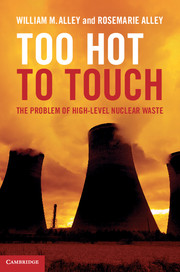Book contents
- Frontmatter
- Contents
- Acknowledgments
- List of units
- List of abbreviations
- Introduction
- Part I The problem
- 1 The awakening
- 2 Brainstorming
- 3 The ocean as a dumping ground
- 4 Radioactivity and atomic energy
- 5 The Cold War legacy
- 6 The peaceful atom and its wastes
- 7 Recycling
- 8 Dry cask storage
- 9 Interim storage
- 10 A can of worms
- 11 WIPP
- Part II The mountain
- Part III No solution in sight
- Appendix Discussion questions
- References
- Index
6 - The peaceful atom and its wastes
from Part I - The problem
Published online by Cambridge University Press: 05 February 2013
- Frontmatter
- Contents
- Acknowledgments
- List of units
- List of abbreviations
- Introduction
- Part I The problem
- 1 The awakening
- 2 Brainstorming
- 3 The ocean as a dumping ground
- 4 Radioactivity and atomic energy
- 5 The Cold War legacy
- 6 The peaceful atom and its wastes
- 7 Recycling
- 8 Dry cask storage
- 9 Interim storage
- 10 A can of worms
- 11 WIPP
- Part II The mountain
- Part III No solution in sight
- Appendix Discussion questions
- References
- Index
Summary
Nuclear energy was conceived in secrecy, born in war, and first revealed to the world in horror. No matter how much proponents try to separate the peaceful from weapons atom, the connection is firmly embedded in the minds of the public.
K.R. SmithIn June 1948, Robert Oppenheimer delivered a stinging indictment to the AEC Commissioners for dragging their heels on what he considered the most crucial application for atomic energy – nuclear power. While harboring serious misgivings about the weapons application of atomic energy, Oppenheimer fervently believed in the peaceful uses of the atom. “We despair of progress in the reactor program,” the Father of the Atomic Bomb told the Commission. As scientific director of the Manhattan Project, Oppenheimer had steered the project to its successful and horrific completion in an astonishing two-and-a-half years. Now, almost three years since the war ended, the AEC had made next to no progress with nuclear power.
Oppenheimer was not alone in his frustration. Enrico Fermi considered reactor development to have lost its zest. In the early days of atomic energy, a period that Oppenheimer cheerfully referred to as one of “general deviltry,” a small group of scientists was allowed to work with almost complete independence. Such autonomy had been replaced with mounting lists of rules and regulations. From the perspective of these atomic pioneers, the AEC was increasingly bogged down and handicapped by hesitancy. The days of vision and daring appeared to be in the past.
- Type
- Chapter
- Information
- Too Hot to TouchThe Problem of High-Level Nuclear Waste, pp. 84 - 92Publisher: Cambridge University PressPrint publication year: 2012



